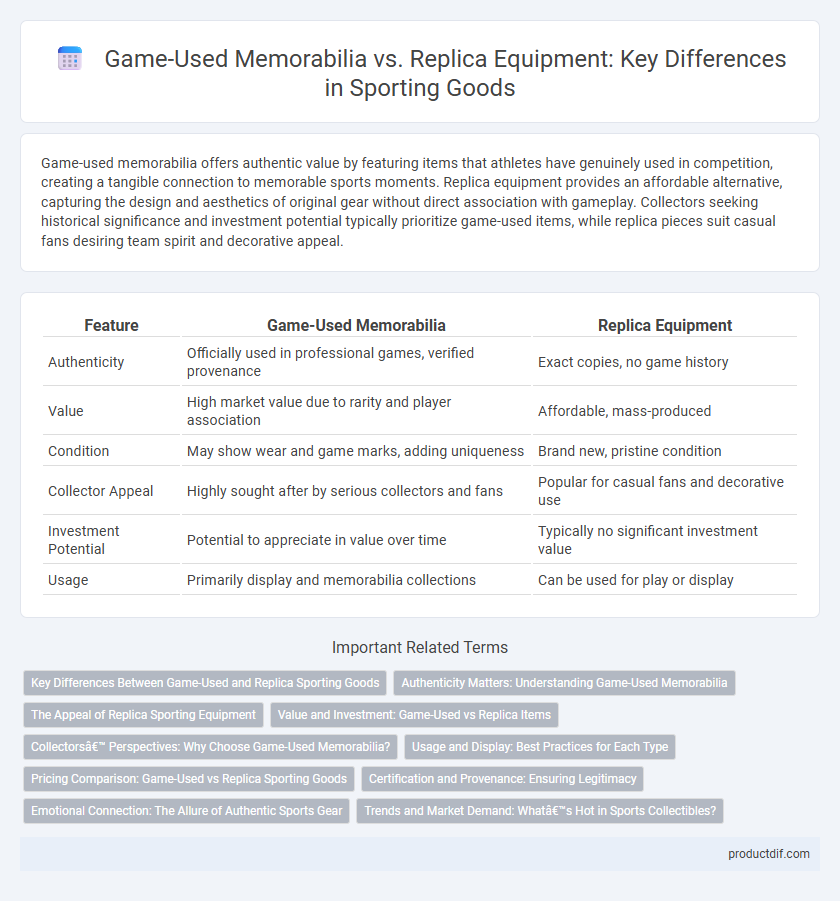Game-used memorabilia offers authentic value by featuring items that athletes have genuinely used in competition, creating a tangible connection to memorable sports moments. Replica equipment provides an affordable alternative, capturing the design and aesthetics of original gear without direct association with gameplay. Collectors seeking historical significance and investment potential typically prioritize game-used items, while replica pieces suit casual fans desiring team spirit and decorative appeal.
Table of Comparison
| Feature | Game-Used Memorabilia | Replica Equipment |
|---|---|---|
| Authenticity | Officially used in professional games, verified provenance | Exact copies, no game history |
| Value | High market value due to rarity and player association | Affordable, mass-produced |
| Condition | May show wear and game marks, adding uniqueness | Brand new, pristine condition |
| Collector Appeal | Highly sought after by serious collectors and fans | Popular for casual fans and decorative use |
| Investment Potential | Potential to appreciate in value over time | Typically no significant investment value |
| Usage | Primarily display and memorabilia collections | Can be used for play or display |
Key Differences Between Game-Used and Replica Sporting Goods
Game-used sporting goods display authentic wear and unique details from actual competition, offering collectors undeniable provenance and singular value. Replica equipment, while visually identical, lacks the genuine battle marks and historical significance but provides affordable options for fans seeking aesthetic appeal. Key differences include rarity, authenticity certification, and price, with game-used memorabilia often commanding higher market demand and investment potential.
Authenticity Matters: Understanding Game-Used Memorabilia
Game-used memorabilia holds unparalleled value due to its direct connection to athletes' performances, offering genuine authenticity that replicas cannot replicate. Collectors prioritize items verified by trusted sources such as team certifications, holograms, and provenance documentation to ensure legitimacy. Unlike mass-produced replica equipment, game-used items embody historical significance and personal stories, making authenticity the cornerstone of their appeal in the sporting goods market.
The Appeal of Replica Sporting Equipment
Replica sporting equipment offers fans affordable access to iconic gear, capturing the design and feel of game-used items without the high cost or rarity. Manufactured with attention to detail, replicas provide durability for display or casual play, making them ideal for collectors and enthusiasts alike. This accessibility enhances fan engagement by allowing broader participation in the sports culture through tangible, authentic-like products.
Value and Investment: Game-Used vs Replica Items
Game-used memorabilia holds significantly higher value and investment potential compared to replica equipment due to its authenticity and direct association with athletes' performance in actual competitions. Collectors and investors prioritize game-used items because their scarcity and provenance provide greater historical significance and market demand. Replica equipment, while more affordable and accessible, lacks the uniqueness and verified connection to sport events, making it a less attractive asset for long-term investment.
Collectors’ Perspectives: Why Choose Game-Used Memorabilia?
Collectors prioritize game-used memorabilia for its authentic connection to historic moments and player performance, which replica equipment lacks. The unique provenance and physical wear on game-used items enhance their rarity and value, making them highly sought after in sports memorabilia markets. This tangible link to sporting events provides emotional resonance and investment potential that replicas cannot replicate.
Usage and Display: Best Practices for Each Type
Game-used memorabilia carries authentic value from actual sporting events, making it ideal for display in secure, climate-controlled environments to preserve its condition. Replica equipment offers a cost-effective alternative for fans seeking aesthetic appeal and memorabilia without the fragility of game-used items, suitable for everyday display or casual use. Proper labeling and certification enhance the authenticity of game-used memorabilia, while replicas benefit from consistent maintenance to retain their visual appeal.
Pricing Comparison: Game-Used vs Replica Sporting Goods
Game-used sporting goods typically command higher prices due to their authentic use in professional competitions, often accompanied by certificates of authenticity that boost their collectible value. Replica equipment, while visually similar, is mass-produced and significantly more affordable, targeting fans who seek the aesthetic experience rather than the tangible connection to a sporting event. Pricing for game-used items can be exponentially higher, sometimes reaching thousands of dollars, whereas replicas generally remain within a few hundred dollars, making the choice dependent on budget and collector interest.
Certification and Provenance: Ensuring Legitimacy
Certification and provenance are critical factors distinguishing game-used memorabilia from replica equipment in the sporting goods market. Authentic game-used items typically come with official documentation from reputable organizations or teams, verifying their origin and usage during professional events. Provenance records, such as photographs, player signatures, and authenticated serial numbers, further establish legitimacy and increase the item's value to collectors and enthusiasts.
Emotional Connection: The Allure of Authentic Sports Gear
Game-used memorabilia holds unparalleled emotional value as it directly links fans to historic moments and athletes' real performances. Authentic sports gear carries the tangible energy and stories of the game, creating a deeper personal connection compared to replica equipment. This emotional allure drives collectors and enthusiasts to seek genuine items that embody passion and legacy.
Trends and Market Demand: What’s Hot in Sports Collectibles?
Game-used memorabilia continues to dominate the sports collectibles market, driven by authenticity and player provenance that significantly increase value and demand among enthusiasts. Replica equipment remains popular due to affordability and accessibility, appealing to casual fans and new collectors seeking visually appealing items without the high price tag. Current trends show a rising interest in digital collectibles tied to game-used moments, blending physical and virtual assets to capitalize on fan engagement and emerging technologies.
Game-used memorabilia vs Replica equipment Infographic

 productdif.com
productdif.com